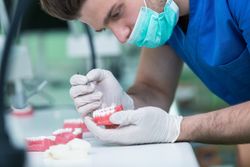
When you need more than a few teeth pulled to avoid oral health infections such as abscesses, it’s time to research dentures and partials. Both replace missing teeth to restore your smile and prevent such problems as facial sagging and bone loss. Below, learn about these options to determine what’s wisest for your dental health needs.
Dentures
Complete dentures replace all teeth. They are customized for each dental patient’s mouth and are typically installed eight to 12 weeks after tooth extractions, when gum tissue has fully healed. Since gum tissue can shrink during this healing period because it lacks stimulation from teeth, the dentist may apply immediate or temporary dentures if the patient is a candidate.
Full dentures sit on top of the gums and remain in place with a special adhesive. They provide a solution to those with severe gum disease or tooth decay because they prevent further infection and support the cheek muscles to avoid a sunken-in look.
Keep dentures in top condition by rinsing them daily to remove food particles. Clean with a soft toothbrush and nonabrasive cleanser to prevent scratches and eliminate bacteria. Place the prosthetics in a glass of water when you aren’t wearing them to avoid warping issues. Add denture tablets to the water for extra cleansing—especially if the prosthetics are stained.
Partials
 When only some teeth need removing, partial dentures provide a viable solution. Like complete dentures, partials are custom-made for each patient. Unlike full dentures, partials are attached to a plastic, gum-colored base and may be connected with a metal framework to hold them in the mouth. They prevent remaining teeth from shifting and causing bite problems while stimulating the gums and jawbone to keep the former tissue from shrinking.
When only some teeth need removing, partial dentures provide a viable solution. Like complete dentures, partials are custom-made for each patient. Unlike full dentures, partials are attached to a plastic, gum-colored base and may be connected with a metal framework to hold them in the mouth. They prevent remaining teeth from shifting and causing bite problems while stimulating the gums and jawbone to keep the former tissue from shrinking.
Care for removable partials in the same way you would for complete dentures. Rinse the prosthetics of food debris before using a soft toothbrush or denture brush and denture paste to clean them. Dissolve denture tablets in a cup of water to soak your partials when you aren’t wearing them, which keeps them stain-free. Rinse partials as well as regular dentures before putting them back in your mouth if you use tablets.
Discuss dentures and partials with the dentist at Clements Family Dentistry in Hamilton, OH, to maintain your smile. A member of the American Dental Association, Ohio Dental Association, and The Keely Dental Society, Dr. John A. Clements, DMD, has served the community for over 20 years. Call (513) 887-7027 today to make an appointment, or visit the dentist online for more about dentures and partials.
About the Business
Have a question? Ask the experts!
Send your question

